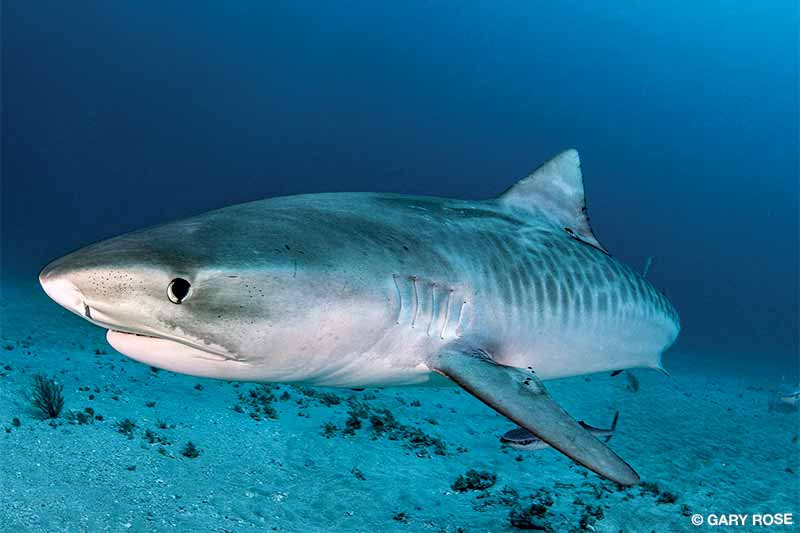The sun was shining brightly over the glassy, deep blue waters offshore. It was a holiday weekend, and all was going well when a young couple boarded the boat and carelessly dumped all their gear on the deck. Watching them inhale their breakfast and spill coffee on another diver, I had a premonition that this day would not end well, especially because the charter was for a shark dive.
Their attention seemed to be on anything but the upcoming dive, and they distracted everyone else on the boat, including the divemaster and deckhands. The couple’s limited English proficiency was compounding their lack of preparedness and knowledge for this dive. In retrospect, it was evident that they either did not pay attention to or understand the predive briefing, or both.
As noted in previous Alert Diver articles regarding adverse events, there is almost always a cascade in four phases: the trigger, the disabling agent, the disabling injury and the cause of death. Individually, each of these events is avoidable. If someone recognizes one at the time of occurrence, it is an opportunity to react and attempt to mitigate the risk before it becomes a problem. In root cause analysis of adverse events, the most significant factors are the lack of recognition and failure to react to the event, which leads to subsequent events that culminate in a disastrous result such as a serious injury or loss of life.
After descending, we were all lined up on the ocean floor at a predesignated and appropriate distance from the shark feeder. The divemaster thoroughly discussed the plan at our predive briefing. The couple appeared to be following instructions. At least 20 lemon sharks were swimming in and around the shark feeder and divers, offering amazing views and photo opportunities.
Shortly afterward, a beautiful 12-foot (3.6-meter) female tiger shark joined the group. She was a regular seasonal visitor to this area. The divemaster had made a particular point of discussing tiger shark behavior and how we should behave if one came into the area. We were all in awe as we watched this huge tiger shark being hand-fed. It was a photographer’s dream to observe and photograph such an inspiring apex predator each time she circled and returned for more. My whimsical musings were suddenly interrupted when the shark feeder gave the previously instructed auditory and hand signals that notified us to rise as a group and station ourselves down current from the shark feeder.

I could not believe my eyes when I spotted the couple well below us, lollygagging on the sand as the rest of the group followed instructions and drifted up into the safe and protective arrangement. The shark feeder kept repeating the auditory signal to alert them. As he reached for more bait to feed the tiger shark, he pointed at the couple and moved his hand to attract their attention. This motion was the same as he had been using to offer bait.
The entire incident took a nanosecond. I was less than 10 feet (3 meters) away. The shark took what she thought was bait from the feeder, biting down on the waving, empty hand and jetting away. I never saw one flee before; tiger sharks usually circle for more fish. It was as if she knew she made a mistake. I was still processing what I had witnessed when I saw a billowing cloud of green emanating from the cuff of the shark feeder’s wetsuit. I quickly swam over and escorted him to the surface while holding pressure on his wrist. I felt a very soft and unnatural hand through his glove, so I held it with firm compression. The cloud of green kept expanding rapidly. We did not do a safety stop, recognizing that this was a catastrophic injury event.
The deckhand helped the shark feeder onto the boat. I saw a lot of red everywhere as I ascended the ladder. I immediately fashioned a tourniquet out of a weight belt and tightened it above the injury just enough to staunch the bleeding. I laid him down on the deck to augment blood flow to his brain and applied an oxygen mask while the captain issued a mayday distress call.
It was difficult to feel the extent of the damage to his greatly distorted hand. His glove and wetsuit cuff were crushed together. I elected not to remove his glove for inspection, not wanting to risk further damage. The shark feeder, who had been my friend for many years, was now my patient and was not looking very good. His face was ashen gray from the significant blood loss. I continued holding pressure on his hand and wrist until the marine patrol arrived within minutes. We transferred him to the patrol boat, and off they went with lights flashing and sirens screaming as they headed to shore.
Once on land, he was airlifted to a local hospital and underwent many hours of surgery to revascularize his hand, repair the tendons and nerves, and suture the wounds. My decision not to remove his glove to inspect the damage was correct. The crushed wetsuit cuff and glove and a small attachment of wrist skin were all that had kept his hand in position when I brought him up onto the boat.
When analyzing an incident, the negative outcome unfortunately is not always limited to the diver who initiated the events. In this case the couple who did not follow instructions were the initiators. As seen in this case, the trigger and subsequent disabling events can result in injury for another diver. The couple’s lack of preparedness, failure to follow instructions and inattention to details caused an otherwise vigilant diver to become distracted. This distraction at a critical moment kept the shark feeder from focusing on an extremely delicate and demanding task that he otherwise would have had no problem performing.
© Alert Diver — Q3/Q4 2021